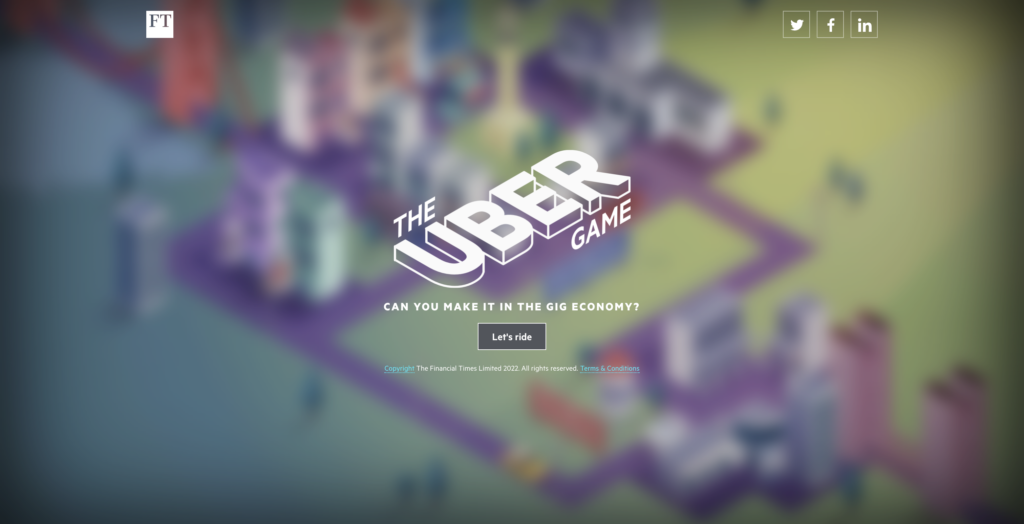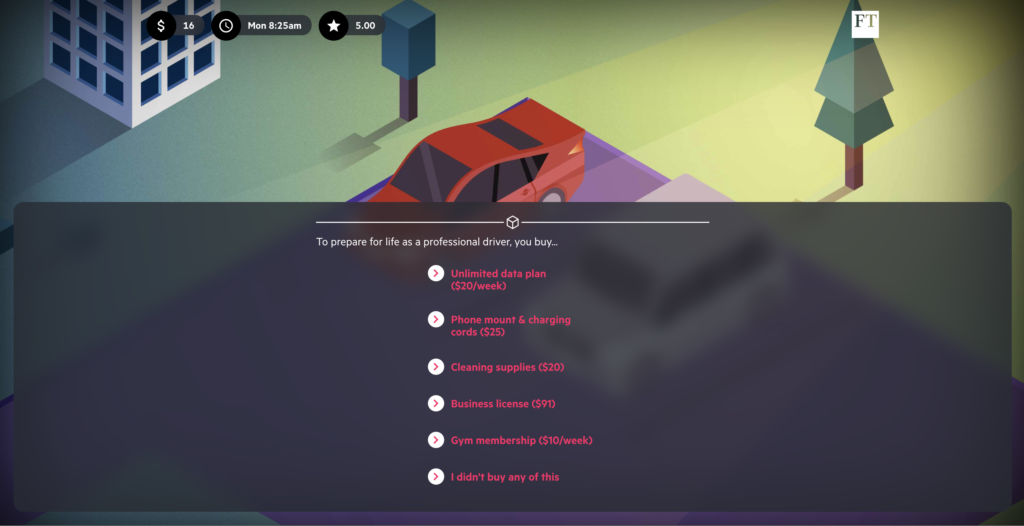In my first play-through of The Uber Game, I chose easy , picked the larger van for the UberXL bonuses, bought the data plan, the phone mount, and some cleaning supplies, and was prepared for an easy ride ahead.
Six in-game days later, on the last day of the week, I had only earned less than 850 dollars, I had been suspended by Uber for staying up too late, and I eventually fell short of the $1,000 goal despite working for almost 80 hours for the entirety of the seven days.
With this week-long journey as an Uber driver in California, The Uber Game is packed with elements of procedural rhetoric.

In the words of Ian Bogost, procedural rhetoric is described as “the art of persuasion through rule-based representations and interactions.”1 It differs from the commonly perceived sense of rhetoric through spoken word and visual imagery as meanings are conveyed and claims are made in constructing rules and allowing the player to execute processes. It is through the rules of a game, and the player’s interaction with them, that allows games to make claims, persuade, and convince.
The player’s experience with The Uber Game is dictated by rules set by the game itself. It is worth noting that The Uber Game is a text adventure game whose narrative relies on rather restrictive multiple choices, and its gameplay mainly consists of the player selecting from limited choices, their contents pre-written and their consequences pre-determined by the game and its designers.
When the protagonist’s car windows are damaged, for example, the player could only either fix it immediately or ignore it and keep on working. When the player is asked to drop off a passenger in a no-parking area, the only options present are refuse and accept – no room for compromise. The player’s input in the game is solely achieved in clicking on one of the choices that are presented by the game itself, and this limitation becomes apparent after a few play-throughs in which many of the events and choices reappear again and again. Chris is always our first passenger, and we always have the chance to spend an evening with our son or join our friends for an evening of gathering.
Thus, it is mainly through the process of the player interacting with these choices that The Uber Game presents to the player the struggles of an Uber driver trying their best to survive in the economy of California and, by extension, in the U.S. In the process of choice making and progressing through the game, the player gradually realizes the difficulty of achieving the $1,000 goal.
In my own experience, it is almost impossible to earn enough money without working for the entire week, skipping the evening with friends, and maintaining the best ratings possible. The game’s rules and processes build up tension and pressure, and every choice seemed to matter more and more near the end of the game, and the game makes the player experience such stress through their interaction with its rules and structural limitations.

The Uber Game is a great reflection of the use of procedural rhetoric. It uses processes to make its claim about the experiences of Uber drivers, greatly benefiting from the interactive nature of its medium. Furthermore, it also exemplifies procedural rhetoric in its intention to pack its meaning-making in its process and to limit the player’s ability to make their own meanings from the game. In this sense, its genre as a multiple-choice text adventure game is both a limitation on player creativity and a great site for procedural rhetoric.
Work Cited
Bogost, Ian. Persuasive Games. MIT Press Ltd, 2010.

I absolutely agree! To add on to your point about the limitations of choice, I think something the Uber Game does really well is demonstrate the dichotomy between earning money and self-care. Many choices in the game force you to sacrifice rest or time with your family for more working hours, and there is, as you said, no compromise; the verdict is there, and you must pick one or the other. Through this, the game really effectively communicates that perhaps, as a professional driver, the most difficult decision you make is how much time you’re willing to burn behind the wheel.
It’s interesting to me to think about procedural rhetoric in text-based games like the Uber Game, wherein there aren’t a vast amount of mechanics for a gamer to familiarize themselves with (and therefore shape their experience with the game). I definitely agree that the game’s agenda of demonstrating the struggle of “making it in the gig economy” is best shown through Bogost’s procedural rhetoric by forcing players to choose and weigh their decisions the way an actual driver would.